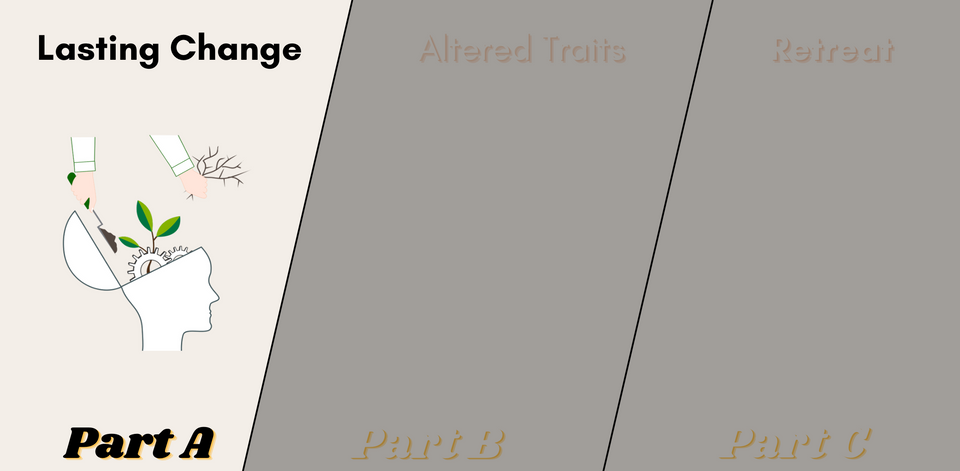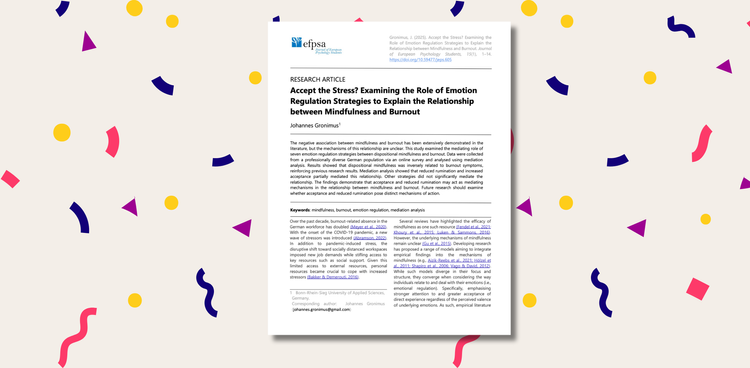Shutting up Part A: Creating lasting Change

10 straight days of silence. No phone or laptop, no music, no pen & paper and no outside contact. Instead, 10 hours of meditation every day.
That’s a Vipassanā Retreat, and by the time this post comes out, I’m halfway through my first one.
How does it feel? Well, I don’t know yet - I scheduled this post before going in. No outside contact and all that.
Why? Well, that I can answer. To most of my friends, this decision was puzzling.
“YOU don’t wanna talk for 10 days? Good luck!”
Was that their way of telling me that I never shut up? Maybe. And yeah, there’s not a lot in this world I enjoy more than great conversations. But there’s a reason I’m excited to give that up for a bit.
That reason: Altered Traits - both the concept, and the book of the same name. So while I’m off being quiet for the first time in ages, enjoy a little pre-scheduled breakdown of the neuroscience behind meditative practice.
Now, a little bit of deja vu: I tried to make this a single post, but neuroscience isn’t the simplest of topics, so it became tiring to read. That means it’s time for another 3-part series.
So today, we’ll cover the concept:
- What are Altered Traits?
- Why are they game-changers for everyday life?
- How do you get there?
Once we’ve got that down, Part B will explore the book - a 400-page deep dive into the neuroscience of meditation, breaking down how fascinating studies conducted at Labs in Harvard, Oxford & the like found the neurological explanations for the effects of these ancient practices. I’ll just keep it a little shorter.
To cap it off, I’ll share my personal experience on retreat for Part C. I just can’t tell you anything about it yet since, at the time of writing, it’s 6 hours until start.
But enough preface. Let’s dive in.
Big Ideas
You see, in psychology, we differentiate between states and traits:
When starting a meditative practice, many people are focused on the meditative state - trying to find a calm moment in a stressful week, or unwind after a long day. And that’s a wonderful place to be. But it doesn’t really explain the 10-day ordeal I’m about to go through.
That explanation comes back to Harvard in the 1970s. There, two grad students named Daniel Goleman (Fun Fact: he later came up with “Emotional Intelligence”) and Richard Davidson had a Big Idea:
“Beyond the pleasant states meditation can produce, the real payoffs are the lasting traits - Altered traits [that] shape how we behave in our daily lives, not just during or immediately after we meditate.”
While they were laughed at back then, 50 years of neuroscientific research ended up proving them right. An enduring meditation practice changes your brain in measurable ways - as it does your behaviour and daily experience.
I know that can sound weird at first. Before studying psychology, I thought of meditation as something completely esoteric - along the lines of touching crystals and tarot cards. I had to write my thesis on Meditation & Burnout to realise the enormous amounts of research that have gone into meditative practices - especially over the last 20 years.
So, how does it work?
Neuroplasticity.
One of the most influential concepts to emerge from Neuroscience in the last 50 years is Neuroplasticity. The idea is simple, but revolutionary:
The central mechanism is explained by a catchy little saying:
“Neurons that fire together, wire together.”
What that means is that whenever brain circuits activate together, their connection becomes stronger, which makes that activation easier the next time.
In practice, this is how learning to ride a bike works: You try to ride, balance for a second, and then fall over. And then, you do it again. And again. Every time you try, the motor neurons required to execute a successful not-falling-over connect more and more.
So the more you try, the easier it is for them to work together - until it becomes so easy that it happens automatically (which is why you don’t have to think about riding a bike now). In the same way, a meditative practice shapes brain circuitry over time.
I like the analogy of working out: Going to the gym once might improve your mood (a state), but won’t make you lift 100kg (a trait). A single meditation session might make you more relaxed afterwards (a state), but won’t make you more present wherever you go (a trait).
Lasting change (both in the gym and in meditation) requires constant practice. Which is why I’m currently in training camp, practising 10 hours per day. But what are those ominous changes?
Well, the proven effects range from a more calm & content daily life to better focus, more vivid experience, less susceptibility to emotional rollercoasters and even prevention of brain aging.
I know, these are bold claims. But join me next week and we’ll break down how they work on a neural level. I’ll make it fun, I promise.
Now if you excuse me, I’ll return to freaking out because I haven’t said a word in 5 days. Have a great day! ☀️




Comments ()